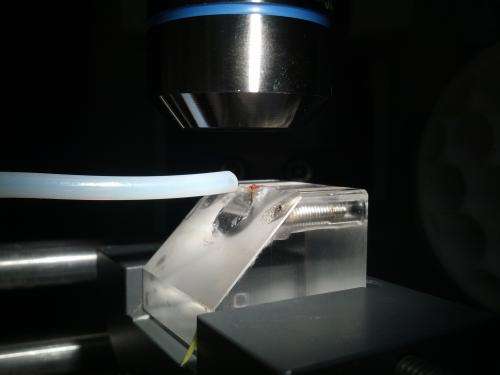Researchers detect cancer cells using olfactory senses of fruit flies

(Medical Xpress)—A research unit in an international cooperation project, led by the Konstanz-based neurobiologist and zoologist Professor Dr. Giovanni Galizia, has been the first to demonstrate that fruit flies are able to distinguish cancer cells from healthy cells via their olfactory sense. In an article, published on 6 January in the international scientific journal "Scientific Report" by the Nature Publishing Group, the researchers of the University of Konstanz and the University La Sapienza in Rome, Italy, describe how characteristic patterns in the olfactory receptors of transgenic Drosophilae can be recorded when activated by scent. Not only could a clear distinction be made between healthy cells and cancer cells; moreover, groupings could be identified among the different cancer cells.
"What really is new and spectacular about this result is the combination of objective, specific and quantifiable laboratory results and the extremely high sensitivity of a living being that cannot be matched by electronic noses or gas chromatography", explains Giovanni Galizia. Natural olfactory systems are better suited to detecting the very small differences in scent between healthy cells and cancer cells. This fact has already been shown in experiments with dogs; however, these results are not objectifiable and are thus not applicable for a systematic medical diagnosis.
The researchers from Konstanz and Rome used the fact that single odourant molecules dock to the receptor neurons of the flies' antenna and thus activate the neurons. In an imaging technique developed by the researchers, the different odourant molecules of the respective scent samples create different patterns of activated neurons, which fluoresce under the microscope when active, thanks to a genetic modification. In the experiment five different types of breast cancer cell lines were analysed, compared to healthy cells and clearly divergent patterns were generated. "As not only cancer cells can be distinguished from healthy cells, but also subgroups were discernible within the cancer cells, it seems that even different types of breast cancer cells can be differentiated via the antenna of Drosophila", explains Alja Lüdke, member of the research unit and researcher at the University of Konstanz.
The results of the interdisciplinary research unit, consisting of biologists and engineers from the field of electronic engineering, are a fundamental groundwork for cancer diagnosis: "The high sensitivity of the natural olfactory receptors, paired with the quickness with which we can generate these test results, might lead to the development of a cheap, fast and highly-efficient pre-screening that can detect cancer cells well before we can discover them with the present diagnostic imaging techniques", stresses Giovanni Galizia.
More information: "More than apples and oranges - Detecting cancer with a fruit fly's antenna." Martin Strauch, Alja Lüdke, Daniel Münch, et al. Scientific Reports 4, Article number: 3576 DOI: 10.1038/srep03576 . Received 01 October 2013 Accepted 06 December 2013 Published 06 January 2014

















